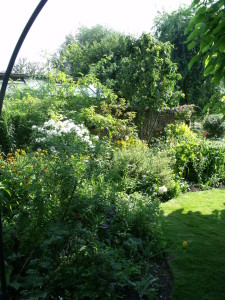THE MODERN MINT BLOG
Plants for Clay Soil
There are lots of plants for clay soil. Difficult as it is to work with, the opportunities to tend a fabulous garden of well-fed, strong and voluptuous plants are second to none (just try not to despair, at the end of the day, when trying to remove the clay from your boots!)

Roses are the absolute first choice for clay.
We made a beautiful rose garden for a client in Hampshire. It was on blue clay and halfway down a gentle slope, so got plenty of water. Each bed had a single variety of rose in, 15 plants per bed, and it looked fabulous as you peered through the hornbeam arch (we chose hornbeam, though not as nice a hedge as beech, because it could cope with the site.)
The client had wanted lavender and box to edge the roses and fill in any gaps – but there is no way they would have survived. Ilex crenata may have coped better, but we doubted its longevity (the site really was wet at times.)
So instead we built a small seating area, added a sculpture and made sure the grass sward was beautiful and cut consistently.
Simple and striking seemed the way forward in this case.
Val Bourne gives a rundown of some fantastic plants in her book The Natural Gardener: The Way We All Want to Garden: Preserving Nature’s Jigsaw. She said…
“Roses (even those old-fashioned beauties), viburnums, hostas, phlox, monardas and asters will love your garden.”
You won’t go far wrong if you just planted these!
The hostas may get eaten by slugs, so if you don’t want the hassle either steer clear of growing them, use copper rings around the plants, or add gravel and grit across the whole bed. Decide on your maintenance capabilities really, and how much time you want to spend on picking off and squashing slugs. It wouldn’t be our first choice of jobs to do…
If you do want to buy hostas then you can see what is on offer here – Jersey Plants Direct – they also sell a Viburnum opulus at a fair price if you type that into the search. Viburnums are solid plants (see the V. carlesii in the picture below) and they provide a cluster of flowers at the start of the season and then berries at the end.
Do plant them!
Cornus is another fine choice for soils that are damp – normally planted for winter stem colour, we also think they do a good job during the summer when in leaf – Cornus alba ‘elegantissima’ has a white margin on the green leaf, which provides a lovely calm backdrop for bigger summer flowers.
Astrantia is a favourite of ours, if you want something perennial. Let some aquilegia seed around it, maybe some campanula and forget-me-not, and you have a soft (possibly too soft? If so, add euphorbia palustris!) late spring scene of delightful flowers.
We always found, when growing dahlias, that lots of water helped. So though you will lose the tubers over winter in clay soil, putting them in for summer will give you a beautiful display. Crocus are currently doing a special offer on dahlias in there ‘bulbs’ section – so don’t miss it, go now!
That should get you started. Just remember to suit the plant to the place – that is what modern garden design is about, and it means the plant is happy and you won’t have as much work to do… unless (and it’s a fine problem to have) they grow too well…
All the plants we’ve talked about can be bought and delivered from Crocus or Jersey Plants Direct – Jersey Plants Direct offer a free delivery no matter the size of the order. Which we think is more than reasonable….
Or for decent books to use as a guide, try Beth Chatto…
Or this one on plants for problem places…
Or this one…
Michael Gibson, New York Topiary Art!
In the New York Times earlier this year was a lovely interview with Michael Gibson, who makes topiary and gardens in New York. The article is here but you may not have access… however, search the internet, find it and have a read. It is great! His philosophy of pruning is especially worth it… Sacred geometry in topiary? Yes please! What a phrase! I think (and speak) of balance, of major and minor, of leaf volume… but sacred geometry might well make it into my topiary teaching lexicon! And the idea of directional trimming? I realise I do this, but …
Topiary Library
I do a lot of teaching topiary. I had the opportunity from my mentor, Charlotte Molesworth, to work on her garden and experiment and test techniques and generally try making shapes without the worry of failure, or being fired, or being sued and run out of business for getting it wrong. This opportunity was essential (along with Charlotte’s insistance that pruning standards had to be high!) in becoming better at topiary. When I look around the world at our cultural vitamins, what we see in the media day in and day out, I see the stupidest and grossest of people …
Clipsham Yew Tree Avenue
With Chris Poole of the European Boxwood and Topiary Society we visited Clipsham Yew Tree Avenue in Rutland. Do you know it? Amazing place! Chris and I were teaching a topiary workshop in order to give local people the skills and technique, and tenacity! to help with the pruning of the avenue and elevate it to something even more special than it already is. Read more about the workshops here. We hope to run a further workshop in September 2026, as well as teach an advanced course too. Check the teaching page through the year as it will be updated …


